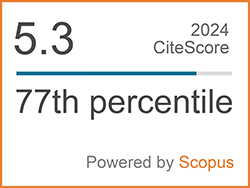A New Fuzzy Sliding Mode Controller for 2-DOF Aero System with Pitch Disturbance
Abstract
Keywords
[1] A. Boubakir, O. Aissa, A. Pasteur, and H. Badi, “Design and experimentation of a self-tuning PID control applied to the 3DOF helicopter,” Archives of Control Sciences, vol. 23, no. 3, pp. 311–331, 2013.
[2] A. Chaudhary, “Trajectory tracking of a 2-DOF helicopter system using fuzzy controller approach,” in 2021 International Conference on Emerging Techniques in Computational Intelligence, 2021, pp. 159–164.
[3] S. Schlanbusch and J. Zhou, “Adaptive backstepping control of a 2-DOF helicopter,” in 2019 7th International Conference on Control, Mechatronics and Automation, 2019, pp. 210–215.
[4] S. Kumar, “Set-point tracking of quanser AERO using SMC in the presence of uncertainties,” in 2021 5th International Conference on Intelligent Computing and Control Systems, 2021, pp. 1595–1601.
[5] K. R. Palepogu and S. Mahapatra, “Synchronous pitch and yaw orientation control of a twin rotor MIMO system using state varying gain sliding mode control,” Arabian Journal for Science and Engineering, vol. 49, no. 12, pp. 16169–16182, 2024.
[6] B. A. Kumar, S. Gayathri, S. Surendhar, S. Senthilrani, and R. Jeyabharathi, “Robust H-infinity controller for two degree of freedom,” in 2019 IEEE International Conference on System, Computation, Automation and Networking, 2019, pp. 1–5.
[7] A. C. Aras and O. Kaynak, “Trajectory tracking of a 2-DOF helicopter system using neuro-fuzzy system with parameterized conjunctors,” in 2014 IEEE/ASME International Conference on Advanced Intelligent Mechatronics, 2014, pp. 322–326.
[8] R. Coban, “Adaptive backstepping sliding mode control with tuning functions for nonlinear uncertain systems,” International Journal of Systems Science, vol. 50, no. 8, pp. 1517–1529, 2019.
[9] W. Zhou, C. Liao, and L. Zheng, “Adaptive backstepping control for a class of uncertain nonaffine nonlinear time-varying delay systems with unknown dead-zone nonlinearity,” Abstract and Applied Analysis, vol. 2014, pp. 1–14, 2014.
[10] W. Min, and Q. Liu, “An improved adaptive fuzzy backstepping control for nonlinear mechanical systems with mismatched uncertainties,” Journal for Control, Measurement, Electronics, Computing and Communications, vol. 60, no. 1, pp. 1–10, 2019.
[11] J. Zhu and K. Khayati, “Adaptive sliding mode control – convergence and gain boundedness revisited,” International Journal of Control, vol. 89, no. 4, pp. 801–814, 2015.
[12] S. Roy, S. B. Roy, J. Lee, and S. Member, “Overcoming the underestimation and overestimation problems in adaptive sliding mode control,” IEEE/ASME Transactions on Mechatronics, vol. 24, no. 5, pp. 2031–2039, Oct. 2019.
[13] T. A. Mahmoud, M. E. Belal, and A. R. Shalaby, “Fractional-order fuzzy sliding mode control of uncertain nonlinear MIMO systems using fractional-order reinforcement learning,” Complex and Intelligent Systems, vol. 10, no. 2, pp. 3057–3085, 2024.
[14] S. G. Vijay kumar singh, shyam kamal, Ankit Sanchan, “Prescribed time adaptive constraint control of an uncertain nonlinear 2-DOF helicopter,” IFAC-PapersOnLine, vol. 56, no. 2, pp. 6877–6882, 2023.
[15] S. M. Schlanbusch and J. Zhou, “Adaptive quantized control of uncertain nonlinear rigid body systems,” Systems & Control Letters, vol. 175, 2023, Art. no. 105513.
[16] F. Gopmandal and A. Ghosh, “LQR-based MIMO PID control of a 2-DOF helicopter system with uncertain cross-coupled gain,” International Federation of Automatic Control – Papers OnLine, vol. 55, no. 22, pp. 183–188, 2022.
[17] M. Öztürk and İ. Özkol, “Comparison of self ‑ tuned Neuro ‑ Fuzzy controllers on 2 DOF helicopter: An application,” SN Applied Sciences, vol. 3, 2021, Art. no. 124,
[18] T. Zhang, B. Zhu, L. Zhang, Q. Zhang, and T. Hu, “Time-varying uncertainty and disturbance estimator without velocity measurements: Design and application,” Control Engineering Practice, vol. 143, 2024, Art. no. 105780.
[19] J. Zhang, Y. Yang, and Z. Zhao, “Adaptive neural network control of a 2-DOF helicopter system with input saturation,” International Journal of Control, Automation and Systems, vol. 21, no. 1, pp. 318–327, 2023.
[20] R. Fellag and M. Belhocine, “2-DOF helicopter control via state feedback and full / reduced-order observers,” in 2024 2nd International Conference on Electrical Engineering and Automatic Control, 2024, pp. 1–6.
[21] E. V. Kumar, G. S. Raaja, and J. Jerome, “Adaptive PSO for optimal LQR tracking control of 2 DoF laboratory helicopter,” Applied Soft Computing, vol. 41, pp. 1–14, 2015.
[22] R. Ganapathy and V. Kumar, “Robust MRAC augmented baseline LQR for tracking control of 2 DoF helicopter,” Robotics and Autonomous Systems, vol. 86, pp. 70–77, 2016.
[23] T. Y. Chun, J. B. Park, and Y. H. Choi, “Reinforcement Q-learning based on Multirate Generalized Policy Iteration and Its Application to a 2-DOF Helicopter,” International Journal of Control, Automation and Systems, vol. 16, no. 1, pp. 377–386, 2018.
[24] S. I. Abdelmaksoud, M. Mailah, and A. M. Abdallah, “Practical real-time implementation of a disturbance rejection control scheme for a twin-rotor helicopter system using intelligent active force control,” IEEE Access, vol. 9, pp. 4886–4901, 2021.
[25] H. O. Wang, K. Tanaka, and M. Griffin, “Parallel distributed compensation of nonlinear systems by Takagi-Sugeno fuzzy model,” in Proceedings of 1995 IEEE International Conference on Fuzzy Systems, 1995, vol. 2, pp. 531–538.
[26] O. Eray and S. Tokat, “Interval type-2 sliding mode fuzzy controller with a time-varying sliding surface,” in 2017 International Conference on Computer Science and Engineering, 2017, pp. 866–871.
[27] Z. Yongsheng, L. Zhifeng, C. Ligang, and Y. Wentong, “Enhanced Fuzzy Sliding Mode Controller for a 3-DOF Parallel Link Manipulator,” in 2010 2nd International Asia Conference on Informatics in Control, Automation and Robotics, 2010, pp. 167–172.
[28] F. Castillo, S. Member, G. Sánchez, and A. N. Model, “2DOF Helicopter Models: A simulation evaluation for MPC applications,” in 2017 IEEE 3rd Colombian Conference on Automatic Control, 2017, pp. 1–6.DOI: 10.14416/j.asep.2025.07.013
Refbacks
- There are currently no refbacks.
 Applied Science and Engineering Progress
Applied Science and Engineering Progress







